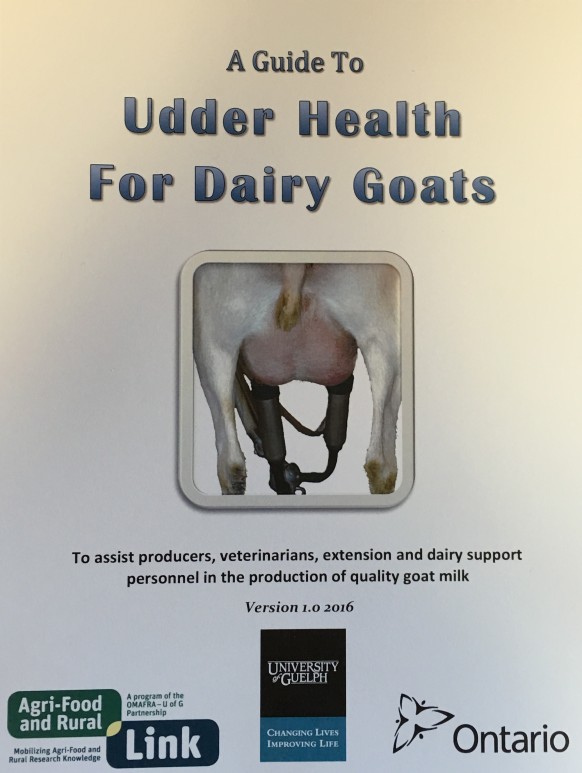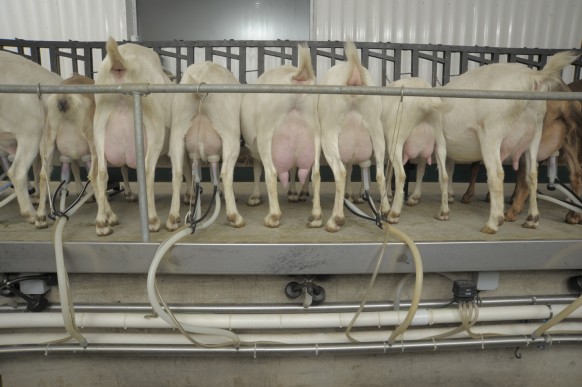 Click here for a PDF of this issue of the Goat Gazette.
Click here for a PDF of this issue of the Goat Gazette.
A new guide book to udder health management in dairy goats is now available. The resource was launched at the Ontario Goat Annual General Meeting and Producer Education Day in Woodstock on February 24.
According to Dr. Paula Menzies, who gave a presentation on udder health at the meeting, the report’s authors have tried to incorporate as much globally available goat research as possible into the new resource.
Menzies, a professor in ruminant health management at the Ontario Veterinary College, wrote the guide in collaboration with Ph.D candidate Colleen Fitzpatrick at the University of Saskatchewan, and Dr. Jocelyn Jansen, Phil Wilman and Mike Foran from the Ontario Ministry of Agriculture, Food and Rural Affairs (OMAFRA).
A significant section of the guide focuses on mastitis detection, treatment and control; other areas covered include normal lactation, cleanliness of the udder and teats, equipment maintenance, milk quality, record keeping, and dairy goat health management.
Here are a few highlights from each area:
Normal lactation
The guide reviews the normal anatomy and physiology of how goats produce milk, including the udder and teat structure, expected lactation curves and what happens to the udder at dry-off.
Mastitis
Mastitis is an inflammation of the udder that causes loss of milk production and affects the quality and yield of milk products like cheese and yogurt. The economic impacts of the disease include costs for treatments, culling, and replacement animals, as well as higher feed and management costs, and lost bonuses or penalties for lower milk quality. Unlike some diseases, mastitis can’t be eradicated so producers have to decide what level of the disease is acceptable and/or attainable on their farms. The cost of a control program must be balanced against the costs and losses caused by the disease.
Clinical signs of mastitis can range depending on the severity of the infection, from changes in the milk to a systemically ill animal with changes to the udder and milk. Most commonly, though, mastitis is subclinical where there is no outward appearance of illness but milk production is affected.
Mastitis pathogens come in two forms: contagious, which stem from animal or fomite transmission, and environmental, where the disease originates from the goats’ environment. Staphylococcus aureus is the most important and common cause of contagious clinical mastitis in goats; environmental causes stem mostly from an unclean barn environment such as the presence of soiled bedding, or dirty water . This includes standing water, like around water troughs that are leaking or overflowing, which can contaminate the udder and teats.
Mastitis can be detected by examining a doe, her udder and milk. When prepping the udder, use a strip cup for a visual inspection of the milk to look for changes in colour and consistency or the presence of flakes – don’t use a hand, boot or the parlour floor or you won’t see the milk clearly. Watch for hot and swollen halves and any signs the doe is ill, such as a temperature or lack of appetite.
Although Somatic Cell Counts are used in dairy cows and sheep for mastitis detection, it is an imperfect test in dairy goats as they display significant variability in the different stages of lactation.
Mastitis can be treated during lactation, as well as during the dry period – consult with your herd veterinarian for the best approach for controlling or eradicating mastitis in your herd. Consider culling does with incurable infections or abscessed or one-sided udders.
Cleanliness of udder and teats
 Keeping a clean udder is important for milk quality. Make sure the udder is clean before the milking unit goes on to minimize dirt in the milk filter. If there is dirt in the milk filter, re-evaluate how clean the goat udders are before milking and consider talking to a veterinarian to develop an udder prep protocol. Clean the teat-end first using udder wash and paper towels or a clean cloth, and wear gloves to keep hand bacteria off the udder. Break the vacuum before removing the milking unit from the udder and use teat dip after milking to protect the open end against bacteria.
Keeping a clean udder is important for milk quality. Make sure the udder is clean before the milking unit goes on to minimize dirt in the milk filter. If there is dirt in the milk filter, re-evaluate how clean the goat udders are before milking and consider talking to a veterinarian to develop an udder prep protocol. Clean the teat-end first using udder wash and paper towels or a clean cloth, and wear gloves to keep hand bacteria off the udder. Break the vacuum before removing the milking unit from the udder and use teat dip after milking to protect the open end against bacteria.
After milking, encourage does to stand by offering them fresh or pushed up feed and water; standing after milking gives their teat-ends time to close before they lay down. Milk doelings first, followed by healthy does; always milk sick does last to prevent the spread of disease and ensure milk from sick does doesn’t go into the bulk tank with the rest of the milk.
Equipment maintenance
Keep milking equipment clean and in good state of repair, and consider a parlour design that will make cleaning easy. When cleaning milking equipment, follow four steps: pre-rinse, hot wash, acid-rinse, and sanitize. The length of time of each step, the temperature, the strength of the chemical and the physical cleaning action will influence the effectiveness of the cleaning process. A milking equipment technician can conduct a wash analysis to ensure everything is correctly calibrated.
Milk quality
Milk quality attributes include flavour, freshness and healthiness. Regulations governing milk quality may vary by region and individual dairy processors may have standards that exceed provincial regulations. Factors that can affect milk quality are high bacterial counts (caused by wet udders or dirty teats, for example), dirty and worn-out equipment, insects, disease, or even milk pick-up frequency. It is important to note that no veterinary drugs are approved for use in goats, so all treatment is extra-label, making it particularly important to pay attention to proper withdrawal times as determined by your herd veterinarian when goats have been treated with medication.
Monitoring and goal setting
Set goals for your operation related to udder health and milk production and track your progress. Keep records of the number of clinical cases of mastitis and the number of does you culled or that died from the disease, and analyze the information. Record-keeping form templates are available in the Udder Health Guide or from Ontario Goat.
Dairy goat health management
Overall health influences the doe’s ability to produce quality milk. A good general health program includes reproductive, gestational, kidding and health management, as well as following recommendations for environmental and nutritional requirements. For more information, please refer to Ontario Goat’s “Best Management Practices for Commercial Goat Production” handbook.
Funding partners of the udder health resource include the Knowledge Translation and Transfer program of the University of Guelph – OMAFRA agreement, Ontario Goat and Hewitt’s Dairy.
To order your copy of the Udder Health Manual please contact Ontario Goat at 1-866-311-6422 or info@livestockalliance.ca. The price for the manual is $45 ($15 for licensed Ontario dairy goat producers). The price includes shipping within Ontario.
